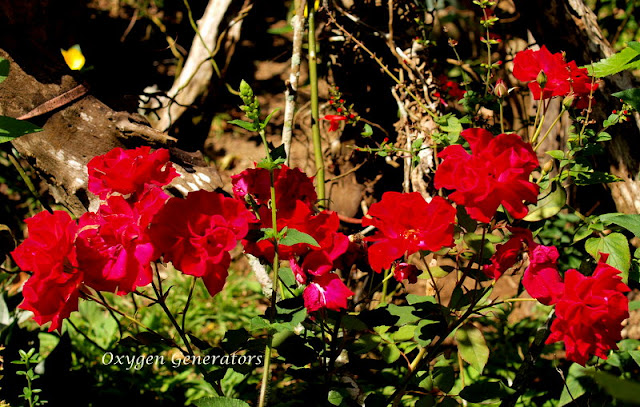Other plant species dry this season, but others show their beautiful reproductive parts. Some of our orchids are trying to be responsible and show the flowers, despite their deprived conditions. We are a bit difficult also with water during our dry season, so they really suffer. The leaves are scorched or totally dry. In fact some of our fruit trees totally died two years ago. These are the trees which we just try to acclimatize here. We try to recycle our kitchen used water for the nearby plants. I have some container tanks and they will come handy when the spring water will be totally dead.
Some of the plants i posted for GBBD are the orchids.
Cymbidium finlaysonianum is native to this country, produce very long spikes and flowers once a year during the dry season. Our clump suffered die-back 2 years ago, and this few plants are trying to regain its full glory. During its heyday, many spikes are produced simultaneously, this time they come only one at a time.
I content myself with getting the macro shots of individual flowers, as the spike is 2x as short as before.
This is an endemic orchid in our region of the country, produce white flowers that has short life but lovely and flower all year round, Pteroceras unguiculatum. The photo above shows a pod which seldom happens. How i wish there is a nearby tissue culturist laboratory for its culture, but there is none. I wasn't able to see the flowers in bloom. I hope one of these weekends they will show the blooms for my camera.
This is another endemic orchid in the country, Phalaenopsis schilleriana . They are normally induced to flower by the long nights, however ours dwindled and bloomed only in time for the dry season. This late flowering is unusual, can be another effect of climate change.
please look at the pollen capsule on top like a bird's head, overlooking a fully welcoming lip below
Dendrobium anosmum or locally called 'sanggumay', another endemic orchid in the country. It produces very long canes fully showing these flowers, but ours has short cane only producing just two here. But i planted this in several areas around the house for its scent. Even just a flower can produce a detectable sweet aroma at 3-4 meter distance.
Even individual flowers of bougainvillea are lovely. Those showy parts are just the bracts.
This Hippeastrum puniceum is also affected by climate change. It normally flowers simultaneously after the first heavy rains in May, but this year some bulbs bloom in March and some in April. I wonder what signals are giving them inconsistencies. But i love the consequences, however the hedges of this i love so much might not give me the simultaneous blooms anymore.
My mother's unscented-thornless roses are blooming wildly too. They are lovely, aren't they.
And, the most predictable shows are near our gate, the Heliconia rostrata. They have always been like this every year at the start of the dry season. I already pruned the crotons that are growing profusely too, to give way for the full view of this display. The good thing about this plant is the long life of those inflorescence. They don't diminish in appearance for two months till the rainy season. Sunbirds, bees and butterflies love to frolic on those drooping beauties.














Lovely orchids!
ReplyDeleteReally beautiful!
ReplyDeleteHappy Garden Bloggers' Bloom Day!
Lea
Lea's Menagerie
Stunning blooms of orchids even though the weather has not been kind to them. Your home sounds as though it is in a very beautiful area, and it is lovely to see some of the beautiful flowers which you obviously take such care of.
ReplyDeleteSo many beautiful blooms on plants that we only see in heated conservatories here! Happy GBBD!
ReplyDeleteYes you are right, and I still have maybe more than doubled the number i've shown here. And most of them are not cared for that much. On the other hand, your blooms in temperate climes we see only in blogposts.
DeleteYour native Dendrobium is spectacular. The reds in your garden are striking. Like you, I have massive clumps of Heliconia rostrata too. The pendulous bracts make a ubiquitous presence in my garden.
ReplyDeleteOh I would love to smell that dendrobium. I was interested in how the long nights affect Phalenopsis Andrea. Could you elaborate a little more as I've never read about this before.
ReplyDeleteOh Rosie, thanks for the interest. This phenomenon is within the topic of photoperiodism, which affect flowering of many plant species. When it is said that a plant is a short day plant, that means it needs long nights to induce flowering (e.g. chrysanthemum). In the case of this species of Phalaenopsi, it is not only long nights but also temperature during our short days that induce flowering. Other Phalaenopsis are just temperature sensitive. Most Phals can only flower in our highlands here, that's also the reason why your colder countries have more Phals growing nicely. Deeper explanations than that might not be needed in your case, because these involve cellular levels, phytochrome, hormones, etc.
DeleteWhat beautiful tropical oxygen generators you have in your area - lovely to see! I have tried growing orchids inside (too cold for them outside here), but they just do not like my house :-)
ReplyDeleteThe secret of all plants nice growth is to know their requirements; mainly light, temperature, water, nutrients. There are orchids whose requirements fit your area so you must choose those whose requirement differences are not so wide with your conditions. Thanks for the visit, hope you drop by again. There are more where they came from, haha!
DeleteWonderful blooms and pictures for GBBD - I am very much taken with the Phalaenopsis orchid. Not usually a big fan of pink, but this one is just captivating.
ReplyDeleteWow, so exciting to see your gorgeous blooms in their natural habitat and not in a hot house! Lovely pictures. Happy GBBD! Cheers, Jenni
ReplyDeleteThat is a huge heliconia clump at your driveway - a beautiful welcome. You are so lucky to have such wonderful orchids as native plants.
ReplyDeleteI love orchids and it must be nice to have them growing in the garden. Mine are captive indoors blooming twice a year, but see outdoors each summer. Love your pink Phal.
ReplyDeleteThe flora in your part of the world is so rich and beautiful. Very exotic for someone from the Northern Hemisphere.
ReplyDeleteThank you for stopping by at Polonica: Home Again.
You are right about the oxygenators. Your lovely site made me take a long, deep breath):-
ReplyDeleteMy goodness your hot orange blooms are wonderful but those orchids steal the show.
ReplyDeleteWhat a wonderful collection of flora! Gorgeous colour - so lush. And I love the contrast of those orange stems of flowers against the bright green in your MoM entry.
ReplyDeleteThank you so much for sharing on Mandarin Orange Monday:)
Your Orchids are just fabulous. You do have some lovely varieties. The Heliconia are looking great too, and those red Roses are gorgeous.
ReplyDelete